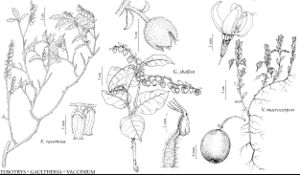Difference between revisions of "Eubotrys"
Trans. Amer. Philos. Soc., n. s. 8: 269. 1842, name proposed for conservation ,.
FNA>Volume Importer |
imported>Volume Importer |
||
| (5 intermediate revisions by 2 users not shown) | |||
| Line 54: | Line 54: | ||
|family=Ericaceae | |family=Ericaceae | ||
|illustrator=Barbara Alongi | |illustrator=Barbara Alongi | ||
| + | |illustration copyright=Flora of North America Association | ||
|distribution=se;e United States. | |distribution=se;e United States. | ||
|reference=None | |reference=None | ||
| Line 59: | Line 60: | ||
|publication year= | |publication year= | ||
|special status= | |special status= | ||
| − | |source xml=https:// | + | |source xml=https://bitbucket.org/aafc-mbb/fna-data-curation/src/2e0870ddd59836b60bcf96646a41e87ea5a5943a/coarse_grained_fna_xml/V8/V8_996.xml |
|subfamily=Ericaceae subfam. Vaccinioideae | |subfamily=Ericaceae subfam. Vaccinioideae | ||
|genus=Eubotrys | |genus=Eubotrys | ||
Latest revision as of 22:47, 5 November 2020
Shrubs. Stems erect; branches spreading, without silvery scales (sometimes hairy). Leaves deciduous; blade (not glaucous), oblong to oblanceolate or obovate, membranous, margins spinulose-serrulate, plane, surfaces glabrous, often unicellular-hairy on major veins abaxially; venation reticulodromous. Inflorescences axillary, fascicled or solitary racemes, 8–25-flowered, (produced on previous year’s wood); (bracteoles 2, distal). Flowers: sepals 5, connate basally, lanceolate or ovate; petals 5, connate basally nearly their entire lengths, white to pale pink, corolla cylindric, lobes much shorter than tube; stamens 8(–10), included; filaments ± straight, flattened, glabrous, without spurs; anthers with 2 or 4 awns proximal to anther-filament junction, dehiscent by terminal pores; pistil 5-carpellate; ovary pseudo 10-locular; stigma 5-lobed, capitate. Fruits capsular, depressed-globose, dry. Seeds 5–10, oblanceoloid or wedge- or crescent-shaped, flattened or not; testa smooth, shiny, reticulate. x = 11.
Distribution
se, e United States.
Discussion
Cassandra Spach, Hist. Nat. Vég. 9: 477. 1840, not D. Don 1834
Species 2 (2 in the flora).
Although Eubotrys sometimes is included in Leucothoë, morphological and molecular work (K. Waselkov and W. S. Judd 2008; K. A. Kron et al. 1999, 2002) indicated that it is actually a sister lineage to Chamaedaphne, rather than to Leucothoë in the narrow sense. Notably, the pedicel bracts are located close to the pedicel apex in Eubotrys, while the bracts are near the base of the pedicel in Leucothoë. The development of the inflorescences on twigs of the current year in autumn has apparently evolved in parallel within Eubotrys and Leucothoë in the narrow sense.
Selected References
None.
Lower Taxa
Key
| 1 | Racemes 3-5 cm, straight, erect or ascending; sepals lanceolate; anthers 4-awned. | Eubotrys racemosa |
| 1 | Racemes 5-12 cm, curved or recurved, spreading or ascending; sepals ovate; anthers 2-awned. | Eubotrys recurva |
